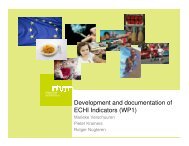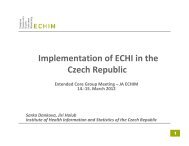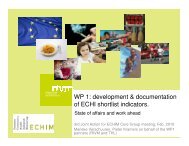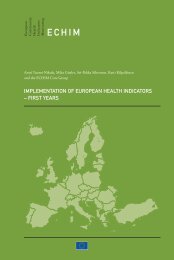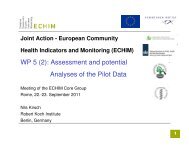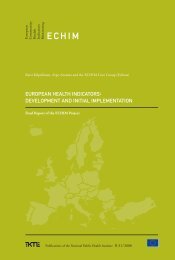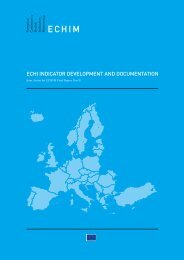Final Report Part III ECHIM Pilot Data Collection Analyses and Dissemination
Part III: ECHIM Pilot Data Collection, Analyses and Dissemination
Part III: ECHIM Pilot Data Collection, Analyses and Dissemination
- No tags were found...
You also want an ePaper? Increase the reach of your titles
YUMPU automatically turns print PDFs into web optimized ePapers that Google loves.
For ECHI#26, it was not differentiated between the allergic <strong>and</strong> non-allergic forms of asthma.<br />
The allergic asthma dominates in children (which have not been covered by EHIS), while 30-50% of adult<br />
asthmatics suffer from the non-allergic type, often provoked by respiratory infections. <strong>Final</strong>ly, there are also<br />
mixed forms of allergic <strong>and</strong> non-allergic asthma. [2].<br />
The President of the European Federation of Allergy <strong>and</strong> Airways Diseases Patients’ Associations (EFA) gave a<br />
summary of the Global Burden of Asthma report <strong>and</strong> commented in 2004 that in the 20 years from the mid<br />
1970s to the mid 1990s, the prevalence of asthma in children rose by 200%.[3]<br />
Asthma prevalence in Europe varies widely, from 18.4% in Scotl<strong>and</strong> to 2.3% in Switzerl<strong>and</strong>. Key findings for EU<br />
included:<br />
• The United Kingdom has amongst the highest prevalence of asthma in the world, with asthma occurring<br />
in 16% of the population<br />
• During the next decade the increase in prevalence of asthma is likely to be particularly marked in the<br />
former socialist countries <strong>and</strong> the Baltic region, as these communities increasingly adopt the Western<br />
lifestyle.<br />
The phenomenon of the quite low prevalence percentages in "new" EU countries may be explained with the ongoing<br />
transitional processes of national health care systems if compared with core EU countries, <strong>and</strong> a general<br />
limited access to health care services. A glance at Eurostat's EU SILC indicator 08 [4] "People with unmet needs<br />
for medical examination by sex, age, reason <strong>and</strong> income quintile (%)" provides the information that particular<br />
persons belonging to the lower three income quintiles report large financial barriers in the mentioned "new"<br />
Member States. So people might suffer from certain types of asthma but can neither afford MD consultations<br />
(therefore no diagnoses) nor suitable medications. If largely privatised health systems <strong>and</strong> severe out-of-pocket<br />
expenditures exclude the poor from adequate health care provision, it poses a challenge for fighting health<br />
inequalities throughout the European Union, too.<br />
Since the lowest prevalence percentages of health status indicators are mostly reported from eastern European<br />
<strong>and</strong> Baltic countries, it will be interesting to follow future developments of asthma prevalence. The next EHIS is<br />
planned for 2014, but also administrative sources or smaller projects could throw some light on the above stated<br />
association [3] between western lifestyle <strong>and</strong> asthma.<br />
43



